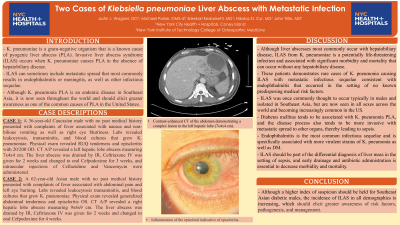Back


Poster Session E - Tuesday Afternoon
Category: Liver
E0594 - Two Cases of Klebsiella pneumoniae Liver Abscess With Metastatic Infection
Tuesday, October 25, 2022
3:00 PM – 5:00 PM ET
Location: Crown Ballroom

Has Audio

Justin J. Wagner, DO
Coney Island Hospital
Brooklyn, NY
Presenting Author(s)
Justin J. Wagner, DO1, Michael Parise, OMS-42, Nikolas St. Cyr, MD1, John Trillo, MD1, Sreekari Kedarisetti, MD1
1Coney Island Hospital, Brooklyn, NY; 2Touro College of Osteopathic Medicine, Manhattan, NY
Introduction: Klebsiella pneumoniae (K. pneumoniae) is a gram-negative organism that is a known cause of pyogenic liver abscess (PLA). When K. pneumoniae causes PLA in the absence of hepatobiliary disease it is defined as invasive liver abscess syndrome (ILAS), and is commonly seen in individuals from Southeast Asia who have diabetes mellitus, cholelithiasis, or steatosis. ILAS can sometimes include metastatic spread that most commonly results in endophthalmitis or meningitis. Although K. pneumonia PLA is an endemic disease in Southeast Asia, it is now seen throughout the world and should elicit greater awareness as one of the common causes of PLA in the United States.
Case Description/Methods: We present two cases of ILAS with metastatic spread causing endophthalmitis in male patients. The first case highlights known epidemiological and medical risk factors of ILAS with a 62-year-old from Southeast Asia who was diagnosed with poorly controlled type 2 diabetes mellitus (DM). The second case highlights an incidence of ILAS without any epidemiological or medical risk factors in a 36-year-old from the United States with no medical history. Both patients required interventional radiology for abscess drainage and intravenous ceftriaxone with subsequent clinical improvement and outpatient follow-ups in primary care and ophthalmology.
Discussion: Liver abscesses most commonly occur with hepatobiliary disease, ILAS from K. pneumoniae is a potentially life-threatening infection and associated with significant morbidity and mortality that can occur without any hepatobiliary disease. ILAS was once commonly thought to occur typically in males and isolated in Southeast Asia, but are now seen in all sexes across the world and becoming increasingly common in the US. DM tends to be associated with K. pneumonia PLA, and the disease process also tends to be more invasive with metastatic spread to other organs, thereby leading to sepsis. Endophthalmitis is the most common infectious sequelae and is specifically associated with more virulent strains of K. pneumonia.
ILAS should be part of the differential diagnosis of liver mass in the setting of sepsis, and due to K. pneumoniae metastasizing to other organ systems, early drainage and antibiotic administration is essential to decrease morbidity and mortality. A higher index of suspicion should be held for Southeast Asian diabetic males, the incidence of ILAS in all demographics is increasing, which should elicit greater awareness of risk factors, pathogenesis, and management.

Disclosures:
Justin J. Wagner, DO1, Michael Parise, OMS-42, Nikolas St. Cyr, MD1, John Trillo, MD1, Sreekari Kedarisetti, MD1. E0594 - Two Cases of Klebsiella pneumoniae Liver Abscess With Metastatic Infection, ACG 2022 Annual Scientific Meeting Abstracts. Charlotte, NC: American College of Gastroenterology.
1Coney Island Hospital, Brooklyn, NY; 2Touro College of Osteopathic Medicine, Manhattan, NY
Introduction: Klebsiella pneumoniae (K. pneumoniae) is a gram-negative organism that is a known cause of pyogenic liver abscess (PLA). When K. pneumoniae causes PLA in the absence of hepatobiliary disease it is defined as invasive liver abscess syndrome (ILAS), and is commonly seen in individuals from Southeast Asia who have diabetes mellitus, cholelithiasis, or steatosis. ILAS can sometimes include metastatic spread that most commonly results in endophthalmitis or meningitis. Although K. pneumonia PLA is an endemic disease in Southeast Asia, it is now seen throughout the world and should elicit greater awareness as one of the common causes of PLA in the United States.
Case Description/Methods: We present two cases of ILAS with metastatic spread causing endophthalmitis in male patients. The first case highlights known epidemiological and medical risk factors of ILAS with a 62-year-old from Southeast Asia who was diagnosed with poorly controlled type 2 diabetes mellitus (DM). The second case highlights an incidence of ILAS without any epidemiological or medical risk factors in a 36-year-old from the United States with no medical history. Both patients required interventional radiology for abscess drainage and intravenous ceftriaxone with subsequent clinical improvement and outpatient follow-ups in primary care and ophthalmology.
Discussion: Liver abscesses most commonly occur with hepatobiliary disease, ILAS from K. pneumoniae is a potentially life-threatening infection and associated with significant morbidity and mortality that can occur without any hepatobiliary disease. ILAS was once commonly thought to occur typically in males and isolated in Southeast Asia, but are now seen in all sexes across the world and becoming increasingly common in the US. DM tends to be associated with K. pneumonia PLA, and the disease process also tends to be more invasive with metastatic spread to other organs, thereby leading to sepsis. Endophthalmitis is the most common infectious sequelae and is specifically associated with more virulent strains of K. pneumonia.
ILAS should be part of the differential diagnosis of liver mass in the setting of sepsis, and due to K. pneumoniae metastasizing to other organ systems, early drainage and antibiotic administration is essential to decrease morbidity and mortality. A higher index of suspicion should be held for Southeast Asian diabetic males, the incidence of ILAS in all demographics is increasing, which should elicit greater awareness of risk factors, pathogenesis, and management.

Figure: Figure 1: Contrast-enhanced computed tomography scan of the abdomen in axial view demonstrating complex lesion in the left hepatic lobe (Case 1).
Figure 2: Inflammation of the episclera indicative of episcleritis (Case 2).
Figure 2: Inflammation of the episclera indicative of episcleritis (Case 2).
Disclosures:
Justin Wagner indicated no relevant financial relationships.
Michael Parise indicated no relevant financial relationships.
Nikolas St. Cyr indicated no relevant financial relationships.
John Trillo indicated no relevant financial relationships.
Justin J. Wagner, DO1, Michael Parise, OMS-42, Nikolas St. Cyr, MD1, John Trillo, MD1, Sreekari Kedarisetti, MD1. E0594 - Two Cases of Klebsiella pneumoniae Liver Abscess With Metastatic Infection, ACG 2022 Annual Scientific Meeting Abstracts. Charlotte, NC: American College of Gastroenterology.
